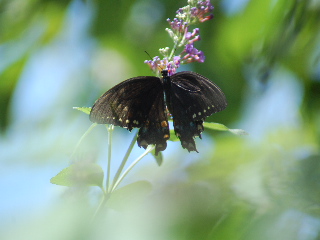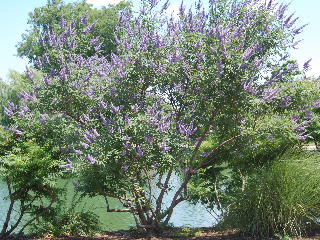
The butterfly bush is the home gardener’s dream shrub—undemanding, fast growing, and producing a profusion of fragrant blossoms.
The butterfly bush (Buddleia spp.) probably gives the greatest return on investment, both literally and figuratively, of any flowering shrub you can integrate into your landscape.
In the early spring, when the garden centers are heavily stocked with plant material, the butterfly bush is generally readily available in large numbers and for a very reasonable price. Buy one or more and plant them in a prominent location where you will be able to observe the summer-long display of blossoms and the steady stream of brilliantly-colored butterflies visiting your garden.
Full sun and a balanced rich soil are the only requirements for your butterfly bush to produce lush foliage and loads of blooms. And, even if conditions are less than ideal, it doesn’t seem to matter that much to the butterfly bush, which will still grow and show to your heart’s content.
The typical butterfly bush produces lilac-colored spikes of flowers from early summer until the frosts of autumn put an end to the show. After the leaves die back, the plant can be cut back severely, all the way to the ground if you like, as the tender top growth will often be killed back anyway from the severity of the winter cold.
Since the butterfly bush grows so rapidly once the spring growth is underway, and because it is a summer-blooming plant that forms its flower buds on the current season’s wood, the extreme fall pruning will not adversely affect flower production during the following summer.

It is not unusual for a butterfly bush to reach a height of 12 feet or more and a spread in excess of 5 or 6 feet in a single season of growth. If the top growth does become excessive or too over-reaching for the site you have chosen, you may want to prune your shrub back to control its shape and spread; just remember that the swap off will be that you will not have as many blooms on the plant.
Although the butterfly bush does reward you with a steady supply of very fragrant blossoms, it is not recommended that you cut the blooms and bring them into your house for a tabletop bouquet, as the cut blooms tend to shed when brought indoors and will quickly make a mess on your furniture and floor.
The most commonly grown butterfly bushes are lilac or violet in color, although shrubs of white, pink, red, or pale yellow can sometimes be found.
A butterfly bush or two planted near your patio or deck will provide you with a great opportunity to observe beautiful flowers and butterflies, too, all through the warm-weather growing season. In addition, hummingbirds are often attracted to the bright blossoms of the butterfly bush.
The Butterfly Weed (Asclepias tuberosa), which grows from 1 to 3 feet in height, is actually a form of the milkweed plant. It produces bright orange flowers throughout the summer. These blossoms also attract butterflies to your garden.
Brighten up your yard with the butterfly weed or with the, always popular, butterfly bush!
 The butterfly bush is the home gardener’s dream shrub—undemanding, fast growing, and producing a profusion of fragrant blossoms.
The butterfly bush is the home gardener’s dream shrub—undemanding, fast growing, and producing a profusion of fragrant blossoms.
 It is not unusual for a butterfly bush to reach a height of 12 feet or more and a spread in excess of 5 or 6 feet in a single season of growth. If the top growth does become excessive or too over-reaching for the site you have chosen, you may want to prune your shrub back to control its shape and spread; just remember that the swap off will be that you will not have as many blooms on the plant.
It is not unusual for a butterfly bush to reach a height of 12 feet or more and a spread in excess of 5 or 6 feet in a single season of growth. If the top growth does become excessive or too over-reaching for the site you have chosen, you may want to prune your shrub back to control its shape and spread; just remember that the swap off will be that you will not have as many blooms on the plant.